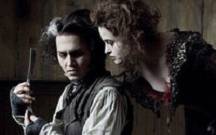|
|
||||
|
by Donald Levit  Sweeney Todd: The Demon Barber of Fleet Street is not yet wrapped, so alongside “greatest moments” from other Tim Burton-directed and/or –produced work, the Film Society of Lincoln Center concluded its recent evening event with three scenes from that Broadway-to-screen “old-fashioned melodrama.” Informal stage talk with Program Director Richard Peña prefacing and following the selections, the director styled the impressive dialogue-and-song three as “Sweeney Todd Comes Home,” “Sweeney Todd Gets Pissed Off,” “Sweeney Todd Gets Down to Business.” To judge by jazz-venue Frederick P. Rose Hall audience applause, and much laughter during the evening, Edward Scissorhands (1990) and The Nightmare Before Christmas (1993) figure among the most fondly embraced. Its title frequently preceded by producer More critically questioned was the fortuitous first of the director’s six collaborations with Johnny Depp, counting Sweeney. With Ed Wood (1994) second, Scissorhands remains “the film I feel closest to,” perhaps in that its jaundiced view of a pastel suburbia bears comparison to that of the career-launching (and equally thin at the end) Warners début, Pee-wee’s Big Adventure (1985). Although the actor is currently the sexiest pirate on filmdom’s earth, the director was not familiar with him back then but suspects he was “probably not happy with the prospect of an eighth or ninth season of ‘21 Jump Street’” as undercover Tom Hanson. “Inside like me,” Depp impressed as “not always looking at himself -- I’m not even sure he’s seen any of the movies we’ve made,” and having a base for a character that could develop spontaneously on the set, in line with Not precisely “Here, put on these scissors and go act,” mind you, but the sense is there, in the self-deprecating tone throughout, an implied refusal to take things so seriously as others might. In black relieved only by horizontal white stripes on the socks, His own drawing not spectacular, after a TV childhood of cartoons and horror films and a California Arts Institute fellowship, Burton apprenticed at Disney, where others’ tremendous talents were underutilized and he learned to doze at his desk as if working, pencil poised in hand, and “fudged my time card, I’m sorry.” After first success with animated black-and-white six-minute Vincent (1982) -- not Van Gogh but childhood idol Price, the creator who would later die before affixing human hands on Edward -- and an Asian-cast fairy tale, came Frankenweenie (1984), half-an-hour of live-action parody that was not released because deemed too frightening for youngsters. Fears and racial darkness, however, lie not deeply buried in the originals of folk/fairy tales, in Disney as well, e.g., the pink elephant drunk dream of Dumbo, the forest fire and mother’s death in Bambi, and Alice in Wonderland, and in grown-up tales from Burton, who praised Roald Dahl’s humor and “not speaking down to kids,” his mordant books among “the few, maybe, I read.” The hero of Batman (1989), his favorite television comic-strip character, is dwarfed by Nicholson’s emotionally and facially distorted Joker, by dizzying heights and sets that are bizarre toys. Though he avoided prompting for a musical version -- “Oh, Jesus! Batman on Ice!” -- and disdains lucrative game, doll and fast-food McDonalds tie-ins, he did direct and produce the nasty-spirited follow-up Batman Returns (1992), sexy bullwhip Catwoman, abandoned sewer-raised Penguin and all. Throwback noir-ish, the spectacular sets of these two big-budgeters are less overkill CGI than Beetle Juice (1988) -- “some of the worst you’ve even seen” -- more good-natured than they but hardly for the kiddies, either. Computer effects are not really his thing, according to Responding to Peña’s leads about some films of his, “American myth, [though] historical accuracy is not high on my list,” Sleepy Hollow (1999) “reminds me of Hallowe’en, the look of old Hammer films,” and for which Depp unsuccessfully petitioned to wear an outsized nose but was instead allowed to “play the action hero like a thirteen-year-old girl.” Oscar-nominated Corpse Bride aka Tim Burton’s Corpse Bride (2005), for which Depp was “terrified to sing” -- he didn’t -- was done at the same time as another Dahl adaptation, Charlie and the Chocolate Factory (2005), in which the Michael Jackson face makeup was topped by a pageboy bob “hairdo based on Vogue’s Anna Wintour.” By “family” in filmmaking, (Photo from Sweeney Todd: The Demon Barber of Fleet Street.. © 2007 Paramount Pictures. All Rights Reserved.) |
||
|
© 2025 - ReelTalk Movie Reviews Website designed by Dot Pitch Studios, LLC |



